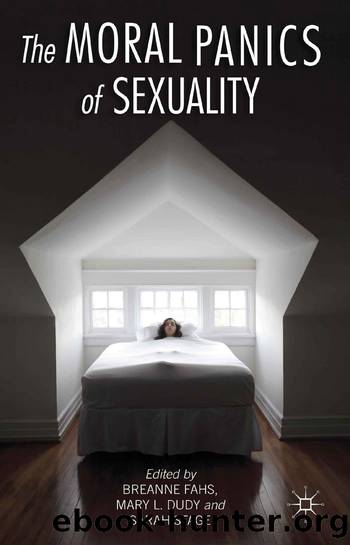The Moral Panics of Sexuality by B. Fahs

Author:B. Fahs [Fahs, B.]
Language: eng
Format: epub
ISBN: 9781137353184
Publisher: PalgraveMacmillan
Published: 0101-01-01T00:00:00+00:00
Vampire mythology, then and now
âIâm doing a study of the young girlâs head and shoulders. You wonât object to removing your blouse, will you?â
So begins an oddly homoerotic scene in Draculaâs Daughter, the sequel to Bela Lugosiâs famous Dracula and Hollywoodâs first vampire franchise. I deem the sceneâs innuendo odd for two reasons: (1) It was filmed for mass release in 1936; (2) Itâs also a scene between two women.
Marya Zeleska, Draculaâs now orphaned daughter, has been seeing a psychiatrist for addictive behaviors and uncontrollable urges. The doctor is unaware that Zeleska seeks escape from her vampiring ways now that her father is dead. In true 1930s psychiatric horror, the doctor advises Zeleska to face her addiction one on one (not without first referencing how alcoholism can be cured by shutting a drunk up alone with a bottle of liquor). The idea is to confront and beat oneâs addiction head on.
Zeleska is taking his advice. An artist, she has hired a homeless young girl off the street to model for her and hopes to avoid hurting the girl.
âYou have beautiful hands, but theyâre so white and bloodless,â Zeleska says.
âTheyâre cold, Maâam,â the girl, Lily, replies.
â⦠Finish your wine. It will warm you. Stand by the fire for a moment. You mustnât catch cold,â Zeleska says calmly but authoritatively in staccato-like sentences. Lily complies, and Zeleska watches the girl as she warms herself by the fire. Lily has already removed her blouse and holds her undergarments by their now fallen straps so as not to fully expose her breasts. She misunderstands why the artist is staring at her exposed neck and shoulders.
âWhy are you looking at me that way? Wonât I do?â the model asks.
âYes, youâll do very well indeed,â Zeleska assures her, removing an old jewel she uses to hypnotize victims. She begins to explain the jewel to Lily.
âI donât think Iâll pose tonight. I think Iâll go if you donât mind,â Lily says plainly, but she doesnât move. She has begun to stare back at Zeleska, not a trace of fear on the young girlâs expressionless face. âPlease donât come any closer,â Lily says.
The audience now sees only Zeleskaâs face, smiling baby-like as it moves slowly off the screen and toward Lily. Zeleskaâs face is off-center, and the camera is slightly out of focus. The scene ends, Lily screaming.
Traditionally, the vampire begets mixed feelings of attraction and repulsionâa visceral ambivalence intended to make readers second guess their basest or most primal urges. For Marya Zeleska, those primal urges evolve into addictive tendencies. Bram Stokerâs Dracula (1897), the novel from which almost all vampire lore springs, reacted against Victorian sexual repression through the introduction of a foreign character, the culturally strange Count Dracula. Character Jonathan Harker, a London lawyer, writes in his journal while traveling to meet the Count, âThe impression I had was that we were leaving the West and entering the Eastâ (Stoker 2003, 7). Stoker shows, like his contemporaries, that conversations about sex are best when taken place outside of the Empire.
Download
This site does not store any files on its server. We only index and link to content provided by other sites. Please contact the content providers to delete copyright contents if any and email us, we'll remove relevant links or contents immediately.
Getting It, Then Getting Along by L. Reynolds Andiric(631)
Religion and Politics Beyond the Culture Wars : New Directions in a Divided America by Darren Dochuk(451)
Global Justice, Christology and Christian Ethics by Lisa Sowle Cahill(411)
Positive Psychology in Christian Perspective: Foundations, Concepts, and Applications by Charles Hackney(342)
Forgiveness and Christian Ethics by Unknown(329)
Douglas Hamp The First Six Days by Unknown(260)
The Horrors and Absurdities of Religion by Arthur Schopenhauer(243)
Insurgency, Counter-insurgency and Policing in Centre-West Mexico, 1926-1929 by Mark Lawrence(234)
Christian Martyrdom and Christian Violence by Matthew D. Lundberg;(223)
The Oxford Handbook of Greek and Roman Mythography by R. Scott Smith;Stephen M. Trzaskoma;(217)
Beyond Heaven and Earth by Gabriel Levy(210)
God and Eros by Patterson Colin;Sweeney Conor;(208)
The Bloomsbury Reader in Christian-Muslim Relations, 600-1500 by David Thomas;(205)
Autobiography, Volume 2: 1937-1960, Exile's Odyssey by Mircea Eliade(197)
Cult Trip by Anke Richter(194)
Witches: the history of a persecution by Nigel Cawthorne(192)
An Introduction to Kierkegaard by Peter Vardy(180)
The Myth of Disenchantment by Jason A. Josephson-Storm(174)
The Believer by Sarah Krasnostein(173)
